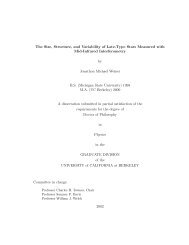Proc. of SPIE Vol. 7013 70130D-1 - The UC Berkeley Infrared ...
Proc. of SPIE Vol. 7013 70130D-1 - The UC Berkeley Infrared ...
Proc. of SPIE Vol. 7013 70130D-1 - The UC Berkeley Infrared ...
- No tags were found...
You also want an ePaper? Increase the reach of your titles
YUMPU automatically turns print PDFs into web optimized ePapers that Google loves.
desirable and, as noted above, the sensitivity <strong>of</strong> heterodyne detection for narrow bandwork is as good or possibly better than that for continuum detection.Measurements at various wavelengths and bandwidths produce, as a result <strong>of</strong> dustand atmospheres around stars, a wide variety <strong>of</strong> apparent sizes <strong>of</strong> stars. One ratherextreme case is WHya, where a measurement at 7 mm wavelength gives a size as large asabout 80 mas. However, ISI measurements show that this is due to ionized materialaround the star, which itself is smaller than about 30 mas. <strong>The</strong> apparent sizes <strong>of</strong> starssurrounded by dust have been shown to vary widely with wavelength when measured inthe visible and near IR with relatively broad bandwidths. And a variety <strong>of</strong> apparent sizes<strong>of</strong> old stars are typically obtained using wide bandwidth measurements in the visible andnear IR.All this makes narrow-bandwidth measurements, especially at mid-IR wavelengthswhich penetrate the dust rather well, <strong>of</strong> special value. For an interferometric system withmany telescopes, heterodyne detection has another possible advantage. A heterodynesignal is detected in a single telescope, then sent to an amplifier so it can be amplified asmuch as desired, then divided to be combined with signals from other telescopes toproduce interference fringes. Direct detection does not amplify the stellar signal. Hencethe stellar light itself from one telescope is usually divided and equal amounts combinedwith stellar light from other telescopes. For a system <strong>of</strong> 10 telescopes, individual stellarsignals are hence divided into nine equal parts to obtain all the interference signalswanted. This reduces the sensitivity by a factor <strong>of</strong> 9 (or the number <strong>of</strong> telescopes minus1). A different direct detection system, but requiring many pixels for detection, has beendeveloped by Monnier et al 1 . Heterodyne signals do not lose sensitivity by this process <strong>of</strong>division because <strong>of</strong> the possibility <strong>of</strong> amplification before division<strong>The</strong> ISI system usually measures stellar and dust continuum and radiation byoperating at a frequency where there are no spectral lines. However, it has also beenspecifically tuned to be on spectral lines so the distribution <strong>of</strong> particular molecules aroundstars can be directly measured. For example, NH 3 and SiH 4 have been measured, andfound to form in the dust shells some distance from the stars themselves 2 .<strong>The</strong> stellar motion across the sky means that for a fixed telescope position theinterference signal goes up and down, depending on whether the two signals are in or out<strong>of</strong> phase. <strong>The</strong> relative phase <strong>of</strong> local oscillators in the three ISI telescopes is changed<strong>Proc</strong>. <strong>of</strong> <strong>SPIE</strong> <strong>Vol</strong>. <strong>7013</strong> <strong>7013</strong>0D-3












![Problem #1 [Structure Formation I: Radiation Era]](https://img.yumpu.com/37147371/1/190x245/problem-1-structure-formation-i-radiation-era.jpg?quality=85)



